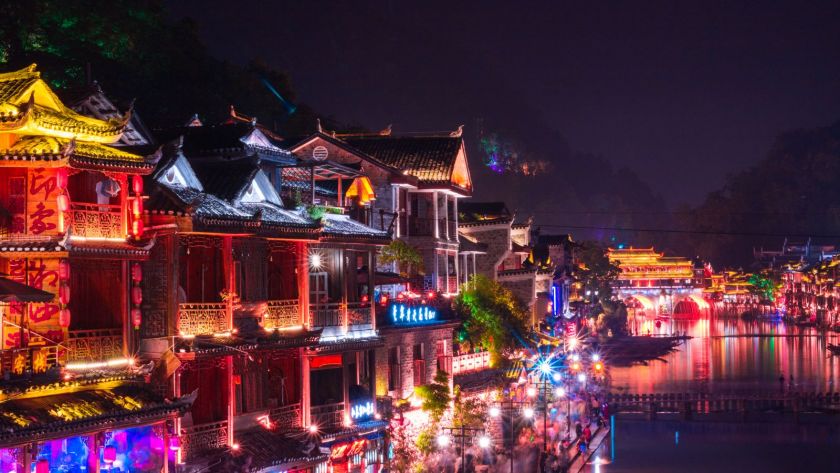Chinese Name: 凤凰古城 Pronunciation: Fèng Huáng Gǔ Chéng
Town Area: About 10 square kilometers
Building Time: 1556
Suggested Visiting Hours: 2 Days
Popular Activities: Strolling and boating
Best Visiting Season: Spring and Autumn (April to September)
Building Function: A place inhabited by Miao and Tujia ethnic minorities.
Address: Fenghuang County, Xiangxi Tujia and Miao Autonomous Prefecture, Hunan Province
| Tickets | Price |
| Joint Ticket 1 | 135 yuan (Including Former Residence of Shen Congwen, Longevity Palace, Fenghuang Ancient Town Museum, and an about 15-minute boat ride on Tuo Jiang River at night) |
| Joint Ticket 2 | 125 yuan (Including Former Residence of Shen Congwen, Longevity Palace, Fenghuang Ancient Town Museum, and an about 15-minute boat ride on Tuo Jiang River by day) |
| South Great Wall | 45 yuan |
| Bonfire Party | 68 yuan ( Free pick-up service from 18:00-19:00. If miss the free pick-up time, you need to go to the party by yourself.) |
| An about 15-min boat ride on Tuo Jiang River(day or night) | 80 yuan |
| Place | Opening Hours |
| The Ancient Town | All-day |
| Attractions(Including Former Residence of Shen Congwen, Longevity Palace, Fenghuang Ancient City Museum, and South Great Wall) | 8:00-17:00 |
| Boat ride on Tuo Jiang River | Opening Hours |
| By Day | 8:00-17:00 |
| At Night | 18:00-22:00 |
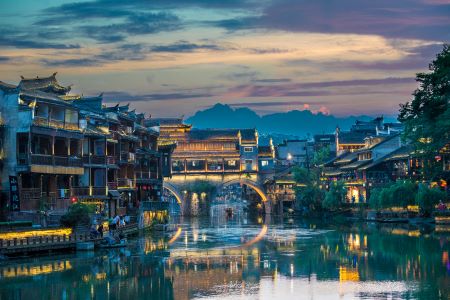
Fenghuang Ancient Town is located in the southwest of Fenghuang County, Xiangxi Tujia and Miao Autonomous Prefecture in Hunan Province with a total land area of about 10 square kilometers. It has a population of about 50,000 with almost 28 different Chinese ethnic groups, most of whom living here are ethnic Miao and Tujia people. Thus, it is known as a typical inhabited area of Chinese ethnic minorities.
Fenghuang Ancient Town, founded in 1556, the 35th year of the reign of Emperor Jiajing in Ming Dynasty. And it was awarded the title of National Historical and Cultural City in 2001. It is the only way which must be passed between Huaihua, Jishou in Hunan Province and Tongren in Guizhou Province. As one of the top ten cultural heritages in Hunan, Fenghuang Ancient Town is comparable to the Lijiang Ancient Town in Yunnan Province and Pingyao Ancient Town in Shanxi Province. It was once praised as the most beautiful town in China by the famous New Zealand writer Louis Rewi.
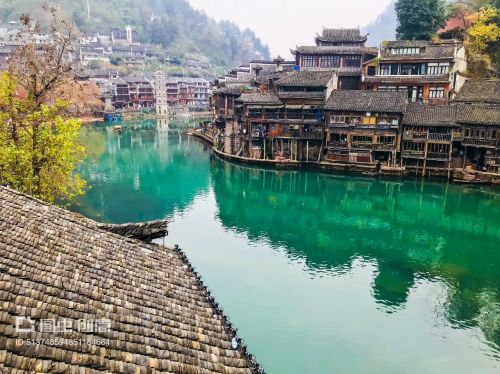
As a national historical and cultural place, the landscape of Fenghuang Ancient Town integrates the natural and humanistic characteristics. In addition, the distinctive ethnic architecture and activities attract thousands of people to come here every year. There are full of national arts and crafts, showing a strong national cultural deposit. People here are kind, simple and hardworking. The environment here is beautiful and graceful. It is these features that make Fenghuang Ancient Town one of the most popular destinations for tourists to travel nowadays.
In 1556, the 35th year of the reign of Emperor Jiajing in Ming Dynasty, Fenghuang Ancient Town was built.
In 2001, Fenghuang Ancient Town was listed as a National Historical and Cultural City.
In 2003 and 2004, it was rated as one of the top 10 best places to visit in China.
In 2005, it ranked the top of the nine ancient towns which are most worthwhile to visit in China and was recommended as a world-famous town by the NHK TV station, a world-famous media. In the same year, the South Great Wall was praised as the most charming resorts in China in the 21st century.
In 2009, it was approved by the Chinese National Tourism Administration for the state 4A-class tourist scenic spot.
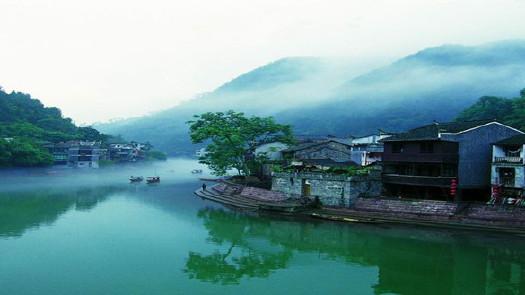
Tuo Jiang River, a tributary of Wushui River, is the largest river in Fenghuang County, and is originated from Nanshan Gorge of Dusha, Heku. It flows through Fenghuang County from west to east and it’s 131 kilometers long with 96.9 kilometers in Fenghuang County.
Tuo Jiang River is of great importance for people in Fenghuang Ancient Town, which is honored as the Mother River of the town, feeding the Fenghuang people from generation to generation. Women dressed in ethnic customs can be always seen washing clothes by the river, and men fishing in the river. Tuo Jiang River also provides a chance for boatmen to make their livings by ferrying visitors up and downstream for sightseeing. Local people are fond of dancing and singing. When working by the river, they often sing folk songs to express their love and passion for life.
The scenery on both sides of the Tuo Jiang River attracts people’s attention as well. The southern bank of the river is the ancient city wall, built with purplish-red sandstone, making it elegant and majestic. Stilted buildings built along the river is the outstanding representative of the culture of Tujia people. Rafting on the river, listening to the boatman’s clear folk songs and looking at the quaint stilted buildings, a sense with the serenity of return to nature arises spontaneously.
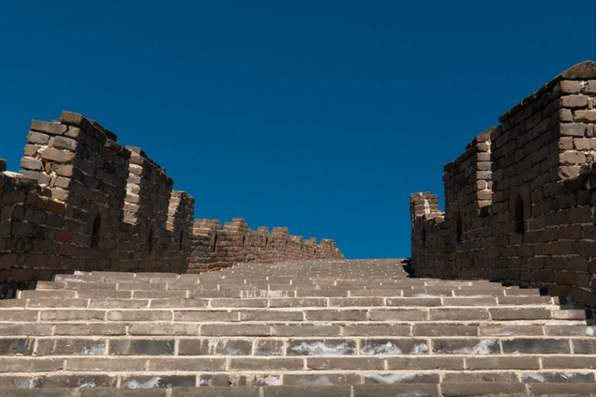
The South Great Wall was built in 1554, starting south of Tingzi Pass of Tongren City in Guizhou Province and north of Xique military camp of Jishou City in Hunan Province. It is 191,000 meters in lengthen, most of which are situated in the Fenghuang Ancient Town. Being one of the most massive ancient buildings in Chinese history, the South Great Wall is about 3 meters in height and 2 meters in width, mostly built on steep ridges.
The South Great Wall was built for the rulers of the Ming Dynasty and the Qing Dynasty to consolidate their power and to suppress the ethnic minorities in southern China, especially the Miao people. Thus, it is often called Miaojiang Great Wall (Great Wall of Miao Territory) as well. Because the military power of the southern minorities is not as strong as that of the northern minorities, the South Great Wall is not as magnificent as the Great Wall in the north. But it is an undoubted part of the Chinese Great Wall and is known as being the only part Great Wall in south China.
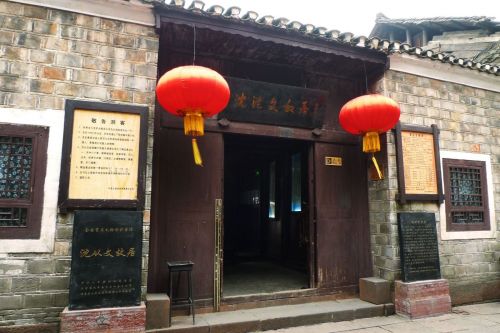
Most people know and learn more about the Fenghuang Ancient Town mostly because of Shen Congwen and his works. Shen Congwen, a famous writer, historian and archaeologist in China, is regarded as the first-class modern literary writer next to Lu Xun in China.
The Former Residence of Shen Congwen is a typical southern style quadrangle courtyard. The buildings are delicate and quaint with a perforated wooden structure and ornamental engraving door and windows. It features a distinctive ancient architecture style of the Ming and Qing dynasties in western Hunan. It was listed as a key cultural relic site under provincial protection in 1991. Nowadays, with displaying the calligraphy work, manuscript and the portrait of Shen Congwen, the former residence has become one of the most attractive cultural landscapes in the ancient town.
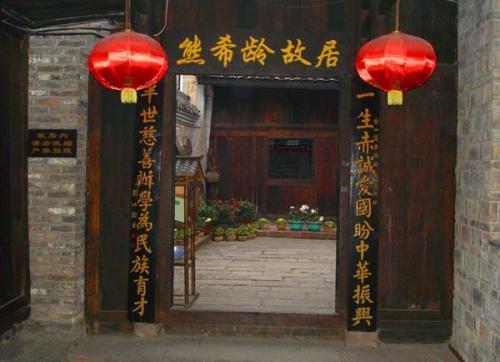
Former Residence of Xiong Xiling, covering an area of 800 square meters, is located in an alley of North Wenxing Street in Fenghuang Ancient Town. Xiong Xiling, known as the prodigy in Hunan, was the first democratically elected premier of the Beiyang Government and was deeply loved by people. The former residence is a typical ancient architecture style of the Miao people. It was opened to the public in 2000.
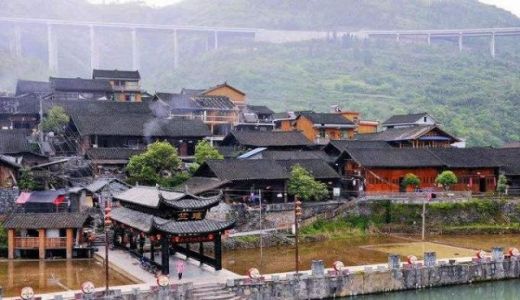
As the predominant residents in Fenghuang County, Miao people have become the famous name brand of the ancient town. Miao Village is a must-see place when going to Fenghuang, if you want to make your trip unforgettable and impressive. Every nationality has its own distinctive culture, so does the Miao.
Miao Village advocates wine culture. Before the visitors enter the village, Miao people will hold a great welcoming ceremony. During the welcoming ceremony, well-dressed Miao girls, standing in lines and singing their folk songs, greeting visitors with a cup of "block-the-way" wine. This is the highest etiquette for Miao people to welcome guests, expressing their blessing to friends coming from far. Besides, the Miao-style banquet which has a history of thousands of years also makes a strong impression on the tourists.
In Miao villages, Miao people with their own special customs can be seen everywhere. Ingenious Miao people are skilled at embroidering, spinning and weaving clothes, so their national customs are almost made by themselves. In addition, silver jewellery, one of the cultural representatives of the Miao, is also the must mention part when talking about the Miao people. They love wearing items of silver ornaments during festivals and activities, or among which the Bonfire Party is famous to tourists. Visitors can also buy silver ornaments and other various kinds of local crafts in the local shops.
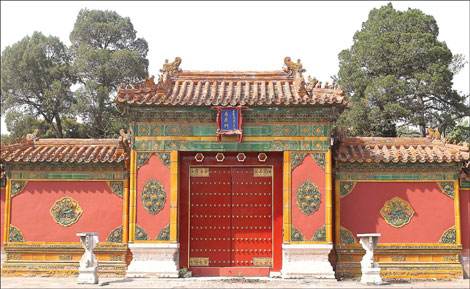
Longevity Palace is situated in the north bank of the Tuo Jiang River. Built by a Jiangxi (one province of China)businessman in 1775, it was once called Jiangxi Assembly Hall. The red external wall of the palace is particularly conspicuous among the green landscapes. The building complex is large in scale and ingenious in design, including more than 20 halls, mansions and chambers. It looks like a temple, but it serves as the Fenghuang Folk Custom Museum, displaying thousands of paintings drawn by art workers in China on the subject of Fenghuang Ancient Town.
Huangsiqiao Castle
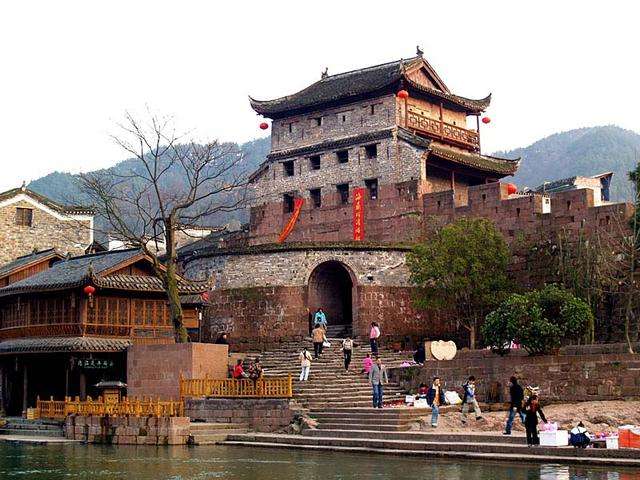
Huangsiqiao Castle was built during the year 687 of the Tang Dynasty for rulers to suppress the minorities. Sitting toward the west, it is a stone castle with an area of 2,900 square meters. The wall of the castle is 5.6 meters high and 2.4 meters wide with a flat surface, showing an exquisite craft at that time. There are three gates of the castle and all of them are built with a Qing-style tower with over 10 meters high, which are extremely spectacular.
Huangsiqiao Castle is the best-preserved stone castle for the military in China. The castle is so solid that it is still intact even though it stands for more than a thousand years. In 1983, it was listed as a provincial key cultural relic under protection.
Nanhua Mountain National Forest Park
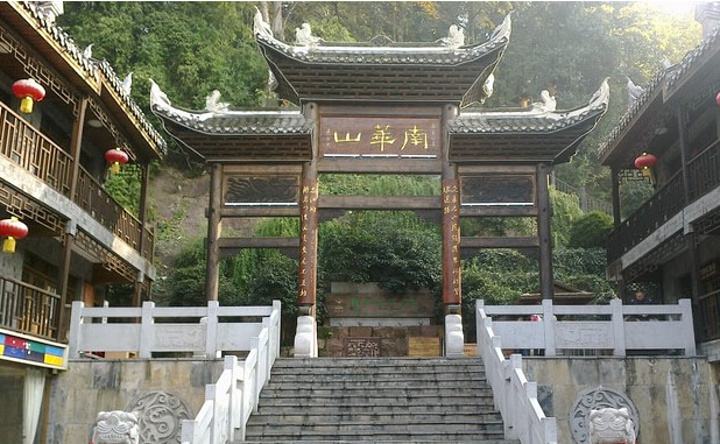
Nanhua Mountain National Forest Park is in the south of Fenghuang Ancient Town, forming a semi-circle surrounding the Fenghuang County. The natural scenery of the park and the landscapes in the town echo each other at a distance, drawing a mysterious and elegant picture with the ancient town in the forest and the forest park in the town. Everyone is charmed with the blue hills, green streams and the gray ancient town.
Nanhua Mountain National Forest Park is a huge green treasure house with thick and luxuriant trees and flowers. There are a great number of precious plants such as metasequoia and ginkgo, and numerous rare medicinal herbs like ginseng. The park makes full use of its rich forest ecological resources and cultural resources to develop the scenic spot with forest ecological tourism as the theme. Generally, it becomes a new hot place that attracts many domestic and international tourists every year.
Fenghuang Ancient Town Museum
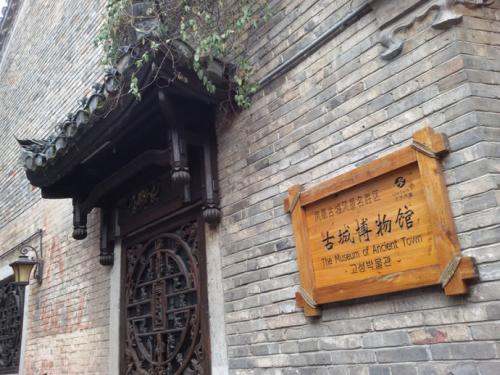
Fenghuang Ancient Town Museum is located in the north of the Former Residence of Shen Congwen. It was the century-old residence of Chen Baojian, an important official in the late Qing Dynasty, covering the area of more than 1,600 square meters. Mr. Lei, the museum’s director, is a folk collector and artist, raising funds to restore the houses. It displays a series of valuable historical materials of Chen Baojian and his families, such as their portraits, relics and household items. The museum has made a great impact on the advancement of the history and culture of Fenghuang Ancient Town.
East Gate Tower
East Gate Tower, formerly called Shenghengmen, is one of the four gates in Fenghuang Ancient Town and is close to the Tuo Jiang River. It was built in the 54th of the reign of Emperor Kangxi of the Qing Dynasty. The tower is 11 meters in height with Xieshan roof eaves, making the building not only solemn but majestic.
Nanhua Mountain National Forest Park→Former Residence of Shen Congwen→Fenghuang Ancient Town Museum→East Gate Tower→ Formal Residence of Xiong Xiling→Boat ride on Tuo Jiang River→Rainbow Bridge
Fenghuang Square→Former Residence of Shen Congwen→Fenghuang Ancient Town Museum→Formal Residence of Xiong Xiling→Boat ride on Tuo Jiang River→Longevity Palace→Rainbow Bridge→East Gate Tower
Fenghuang Square→Former Residence of Shen Congwen→Nanhua Mountain National Forest Park→South Great Wall→Huangsiqiao Castle
Fenghuang is a small county. There is no airport or train station, but you can get to it via nearby cities.
Land at Tongren Fenghuang Airport, a feeder airport about 30km from Fenghuang Ancient Town, and then take a tourist bus from the airport direct to the town, taking about 1 hour. (Tongren City in Guizhou Province is about 60 kilometers east of Fenghuang County )
Land at Zhangjiajie Hehua International Airport and then get to Zhangjiajie Central Bus Station for a direct bus to Fenghuang.
Land at Changsha Huanghua International Airport and then take the airport shuttle bus to Changsha bus stations to take a long-distance coach to Fenghuang.
By Train
Arrive at the train station of Jishou, Huaihua or Tongren, then take a bus to Fenghuang.
By Bus
Changsha→Fenghuang (Around 5.5h-6.5h)
| Changsha departing station | Bus Time | Price |
| West Bus Station | 09:00, 10:50, 14:20, 16:50 | 145 yuan |
| Changzhutan Bus Station | 07:30, 10:00, 13:30, 16:50 | 158 yuan |
| Lituo Express Bus Station | 10:00, 10: 50, 12:30, 13:30, 14:20, 16:00 | 149 yuan |
Zhangjiajie→Fenghuang (Around 3.5h)
| Station | Bus Time | Price |
| Central Bus Station (Near the Zhangjiajie Railway Station) |
08:30, 09:40, 10:00, 12:30, 14:30, 15:30, 16:20, 17:20 | Around 80 yuan |
Jishou→Fenghuang (Around 1.5h)
| Station | Bus Time | Price |
| Jishou North Bus Station (Near Jishou railway station) | 7:00-18:00 | Around 25 yuan |
Tongren→Fenghuang (Around 1h)
| Station | Bus Time | Price |
| Tongren Tourist Bus Station (Near Tongren Railway Station) | 7:30-16:30 | Around 20 yuan |
